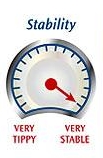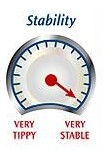 In which I talk about starting a new boat, and cutting plywood without beer.
In which I talk about starting a new boat, and cutting plywood without beer.
Following the successful build and launch of “Eva Won,” I’m now getting started on “Eva Too.” This one is another decked canoe. It will be 13 feet long and built mostly of marine grade plywood using the “stitch and glue” technique. The design is the Mill Creek 13 from Chesapeake Light Craft. This will be Eva’s boat, and she really liked the Mill Creek’s stability rating, its good looks, and its stability rating, and most of all its stability rating.
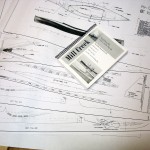 CLC sells complete kits with all the parts completely cut out, but we’re not the “paint by numbers” type. I’ll be building from their plans but doing all the component prep and construction work myself. The plans consist of six sheets and a hefty spiral bound instruction book. Everything looks straightforward and there are literally hundreds of Mill Creek 13s already built. So, I’m confident this will be a good build. Just saying that insures we’ll probably hear stories along the way.
CLC sells complete kits with all the parts completely cut out, but we’re not the “paint by numbers” type. I’ll be building from their plans but doing all the component prep and construction work myself. The plans consist of six sheets and a hefty spiral bound instruction book. Everything looks straightforward and there are literally hundreds of Mill Creek 13s already built. So, I’m confident this will be a good build. Just saying that insures we’ll probably hear stories along the way.
Stitch and glue boats are built from marine grade plywood. The boat building folks up in Maine advise that anything labeled “marine” means only that it costs three times more than normal. This plywood meets that description. Yet, there really is more to it. There is a fairly rigorous standard which requires knot free face veneers, absolutely no core voids, minimal ply thicknesses and counts, waterproof glues (duh), and other size tolerances.
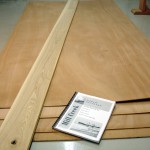 My plywood is Bruynzeel Occume which uses gaboon as the face veneer. While not a true mahogany, gaboon has a similar appearance, is cheaper, and is far more plentiful than mahogany. M. L. Condon in White Plains NY is the lumber yard I frequent. I’ve seen people complain that Condon’s prices are high, and they are. However, once one factors in transportation the price differences disappear. Buying from a distant supplier entails transportation charges of $150-200, and I can drive to White Plains for less than $15. Add to that the ability to walk the yard and hand pick material and Condon works out very well. While I was handing sheets down from an upper level bin to a yard worker below, I mentioned that the top sheet in that stack was a “bit ratty.” It had some edge damage that extended 4-5 inches into the sheet. He said, “Hey. I’d like to get that sheet out of here, how about I knock of $14?” Being familiar with the cut plans, I knew I could work around that damage and gladly accepted a 20% savings. This meager pile of lumber is almost all I’ll need. It is three sheets of 4mm plywood, one sheet of 6mm plywood, and an ash 1 by 6 of which I’ll use a pittance (discounted for that knot). Another stick of spruce or fir from “the Borg” will provide internal framing.
My plywood is Bruynzeel Occume which uses gaboon as the face veneer. While not a true mahogany, gaboon has a similar appearance, is cheaper, and is far more plentiful than mahogany. M. L. Condon in White Plains NY is the lumber yard I frequent. I’ve seen people complain that Condon’s prices are high, and they are. However, once one factors in transportation the price differences disappear. Buying from a distant supplier entails transportation charges of $150-200, and I can drive to White Plains for less than $15. Add to that the ability to walk the yard and hand pick material and Condon works out very well. While I was handing sheets down from an upper level bin to a yard worker below, I mentioned that the top sheet in that stack was a “bit ratty.” It had some edge damage that extended 4-5 inches into the sheet. He said, “Hey. I’d like to get that sheet out of here, how about I knock of $14?” Being familiar with the cut plans, I knew I could work around that damage and gladly accepted a 20% savings. This meager pile of lumber is almost all I’ll need. It is three sheets of 4mm plywood, one sheet of 6mm plywood, and an ash 1 by 6 of which I’ll use a pittance (discounted for that knot). Another stick of spruce or fir from “the Borg” will provide internal framing.
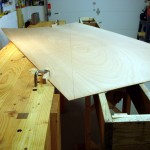 It’s been a very long time since I cut plywood, and the memory makes only part of the experience appealing. Decades ago, I had no saw benches, a couple of sheets of plywood to cut, a circular saw … and a six pack of something cheaper than Budwiser. So, I spread out those six cans strategically, balanced precariously over the wobbly arrangement and went at it with the noisy spinning thing. I survived with all fingers, but resolved, while drinking my bench, to avoid cutting plywood as much as possible. No problem today, no need for a beer can bench. By some unforeseen and unplanned stroke of genius I built both my workbench and the previous boat’s strongback to within 1/4 inch of the same height. They now become two very sturdy sawbenches, upon which a monkey on all fours can use a simple handsaw to make easy work of breaking down the plywood.
It’s been a very long time since I cut plywood, and the memory makes only part of the experience appealing. Decades ago, I had no saw benches, a couple of sheets of plywood to cut, a circular saw … and a six pack of something cheaper than Budwiser. So, I spread out those six cans strategically, balanced precariously over the wobbly arrangement and went at it with the noisy spinning thing. I survived with all fingers, but resolved, while drinking my bench, to avoid cutting plywood as much as possible. No problem today, no need for a beer can bench. By some unforeseen and unplanned stroke of genius I built both my workbench and the previous boat’s strongback to within 1/4 inch of the same height. They now become two very sturdy sawbenches, upon which a monkey on all fours can use a simple handsaw to make easy work of breaking down the plywood.
We’ve had a comfortable Fall this year. The woolly worms are woollier. Deer fur is darker this year than in others. The Old Farmer’s Almanac predicts a colder winter for the Northeast, and Al Gore is too busy PhotoShopping hurricanes to notice. Starting a project that uses lots of epoxy in an unheated workshop nearly guarantees immediate and precipitous temperature decline. We’ll see…
